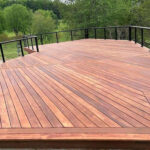Mahogany is an iconic wood for furniture and high end millwork. It has been used for hundreds of years as the prime species based on its ease of use, consistent color, and outstanding appearance. These days genuine Mahogany is not used as often. Not so much because of availability but because the price has been tough to swallow. Regulation of the species has slowed down the supply chain and added a great deal of cost. Users of Mahogany have been searching for an alternate species and this is in large part what has created such a viable African hardwoods market. While there are many species available, Utile has the closest match to Genuine Mahogany but is still mostly unknown to the general buying public.
The primary species in this African market are Khaya (African Mahogany) and Sapele. Both species have widespread use and high availability but lack some of the characteristics that make Genuine Mahogany so prized.
Khaya‘s biggest detractor is inconsistency. So many species fall under the genus Khaya and each has slightly different attributes. All of those species get rolled under one moniker and sold as African Mahogany. This means things like density, color, ease of work and finish are all up for grabs from one board to the next. Khaya is a much cheaper species, sometimes as low as 1/3 the price of Genuine Mahogany however; so many will rely on Khaya for paint grade work.

Sapele is probably the most expensive of the African species that impersonate Mahogany. Even so, it is still around half to 2/3 the price of Genuine Mahogany. It is more dense, stable, and the tree is very large yielding large boards in many thicknesses.
Sapele is much harder than Genuine Mahogany and the highly interlocked grain pattern makes it difficult to work. Tear out in the grain is common and special care needs to be taken when milling. When quartersawn, Sapele has a stunning ribbon stripe to it and as such a separate market for Sapele has been created that is starting to establish the species on it’s own rather than as a Mahogany alternate. This new market is creating a higher demand and we can expect to see Sapele prices rising.
Still relatively unknown, Utile or Sipo (Entandrophragma utile) is gaining notoriety fast as the best Genuine Mahogany substitute out of Africa. In the same genus as Sapele, Utile has a lot of the same properties that make Sapele so popular. Where Utile differs is a not so pronounced interlocking grain for easier, tear out free work.

Utile is lighter than Sapele but only a small percentage heavier than Genuine Mahogany. Utile also is much softer than Sapele and marginally harder than Genuine so Utile has a lot of the easy to work characteristics that makes Genuine so appealing to furniture makers and architectural millwork houses. When quartersawn, Utile will display a mellowed version of Sapele’s striking ribbon stripe but the flatsawn appearance is so similar to Genuine Mahogany as to be almost identical. Utile shows some darker medullary ray lines on a flatsawn surface that can be used to tell it apart from Genuine Mahogany and those darker lines actually add great interest to the board.
Like Sapele, Utile is a very large tree. It is easy to get 12/4 and thicker boards that exceed 10-12″ in width. The lower density than Sapele makes Utile an even more stable species. Because Utile is sold as a single species unlike the conglomerate market of Khaya, it is more consistent across all it’s attributes despite the source. In essence, Utile combines the best of all the species of African Mahogany alternates and is available at around half the price of Genuine Mahogany. Depending on the source and time of year, Utile prices can flirt with Sapele and has occasionally risen above Sapele a small amount. We can expect to see Sapele creating more of a gap as it’s market continues to gain popularity. This leaves Utile as a great solution for someone seeking a great alternative to Genuine Mahogany at a much cheaper price.
What is startling is that Utile is still so unknown. We do our best to inform our customers of this untapped species to save them money but also introduce them to a great lumber species in it’s own right. In some ways, Utile may even be a superior species to Genuine Mahogany, but we aren’t prepared to open that can of worms yet.









Leave a Reply